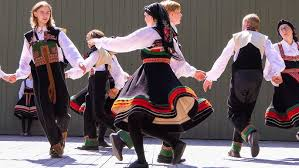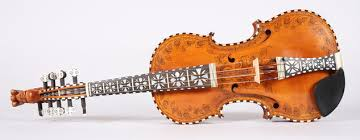Take a Musical Trip: Traditional Norwegian Folk
Traditional Norwegian music has been around for hundreds of years, but there is not very much written works from before the 1840s. The music includes folk dances like Bygdeand that are often performed in ceremonial settings, showcasing couple routines. The dance melodies typically use three-beat or two-beat rhythms, which are tied to weddings, funerals, and festivities such as Christmas. These traditional dances generally lasted longer in more rural farm communities where it was pasted on throughout generations.
This music is primarily categorized into North Germanic and Sami styles. North Germanic music is typically ballads known as kvad. Ballads are generally songs that are written in a poem template that have a slow and sentimental pace. That style of music also includes shorter songs known as stev. A lot of the time these songs are improvised while being sung allowing for a more authentic performance. Sami music stands out for its Joik vocal style, which has chant-like qualities. A lot of the music has long drawn out sounds that are deep from within.
This short clip is a demonstration of what Joik vocal style would sound like in a more traditional setting.
The song "Breaking the Ice," performed by an unknown composer at the 2018 International WISA Conference in South Africa,, gives a better representation of what Sami style fully entails. The song has a very free rhythm allowing for a more meditative fluid sound. The song also does not rely on lyrics, but rather contains syllables and sounds that imitate natural elements. When I listen to this song it makes me feel very immersed and I can not help but zone out as it brings me to a calm.
Along with their unique music styles, Norway also has very distinct instruments. One of their most well known instruments is the hardingfele (also known as the Hardanger fiddle). It has four bowed strings just like a typical violin, but "it also has four or five sympathetic strings, a flat bridge and fingerboard, a shorter neck, and elaborate decoration. The instrument also has higher arching and a smaller body than the standard fiddle," (Tune Music, 11). The instrument is ingrained so much in the culture that it is often called the national instrument of Norway.
In 2013, Ragnhild Hemsing’s performance of the Halling Dance in Norway shows how the Hardanger fiddle adds to the lively, fast-paced feel of traditional Norwegian folk music. The extra strings on the fiddle add a shimmering sound creating a more earthy tone compared to the more precise sound from a violin. The song has a very quick tempo, where it is able to keep the liveliness of the song going throughout. I am not a huge fan of this style of song, but I would really enjoy seeing a live performance, as it seems meant to be enjoyed in person.
Citations
Herron, Issac. "What Is Traditional Norwegian Music?" Youth Time Magazine, 9 June 2021,
"Norwegian Traditional Music." Tune Music Network, https://tunemusicnetwork.eu/rescources/norwegian-traditional-music/
"Music of Norway." Wikipedia, 15 Oct. 2024, https://en.wikipedia.org/wiki/Music_of_Norway#:~=Norwegian%20folk%20music%20may%20be,well%2C%20such%20as%20the%20halling.






Hello Ryder,
ReplyDeleteThis was very interesting. Normally when I think about Norway I do not think about its unique folk music (Frankly in my head I combine all nordic countries down to just ABBA). In the process of reading your article I found out about this other Norwegian instrument called the Bukkehorn and it is very interesting. I’ve linked a video of a Norwegian folk song using it.
https://www.youtube.com/watch?v=vGEa8b-_bUk&ab_channel=Vikingskog
Impressive work. Typically, when I play Norwegian music on Spotify, I get the intense Viking music that'll get you pumped up for battle. But this is a nice break from the Viking music and I didn't think Norway had this kind of music. I think you did an amazing job describing the song Breaking the Ice. I could definitely hear how she drew out the syllables to imitate natural elements. I would've liked to have seen your interpretation an example of a combined performance with the vocals and instruments. Something like this:
ReplyDeletehttps://www.youtube.com/watch?v=DH3vi7Av5Vs
This this is a very soothing type of music, and I love the sound of the Hardanger fiddle, in general fiddles are one of my favorite instruments. You did a great job describing these songs and describing the importance of this type of music to its culture. I wonder if most cultures pass their music on to the next generation, I found that my blog topic, Australian Aboriginal Music, would also pass their music on to the next generation. If you want some more songs with fiddles in you should check out The Devil Went Down to Georgia by Charlie Daniels it is one of my favorite songs with a fiddle in it, I think you might like it.
ReplyDeletehttps://www.youtube.com/watch?v=wBjPAqmnvGA
I loved learning about this. I had never heard this style of music until today. I love how great of a job you did talking about the cultural importance the music has. I love how they are keeping records of their music to pass down from person to person. Did you know that there's two main types of Norwegian folk music? North Germanic and Sami. North Germanic music often includes ballads and improvised songs that are used for work and hymns. Sami music uses a vocal style called joik, which is similar to Native American music.
ReplyDeleteWow! This was super interesting especially because I have never heard of the style before. Interestingly enough, I am 1/4 % Norwegian. You say..." A lot of the time these songs are improvised while being sung allowing for a more authentic performance." I would consider this a form of free-styling as well!! I found this super cool due to the fact that "free styling " is becoming popular in certain places, including the U.S.
ReplyDeleteHey Ryder,
ReplyDeleteI just wanted to say I really enjoyed reading your post! Although I've listened to a fair amount of Norwegian music before, I was unaware of the music diversity and range. I really liked that you included the instruments typically used in song, I feel like a lot of the time we ignore or forget that important aspect of cultural music.